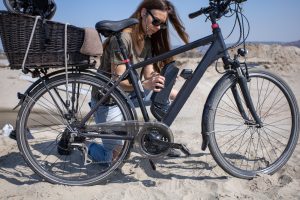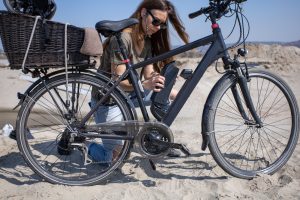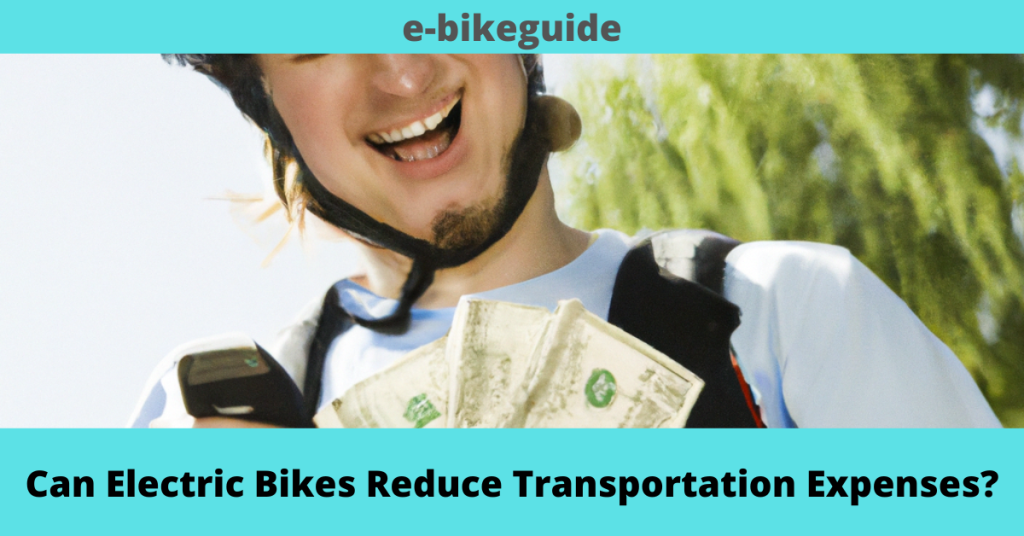Electric bikes could reduce transportation costs.

Electric Bicycles are the future of cycling for most people, but many don’t know it yet! Whether dumping the vehicle on the drive to work or needing a simpler ride to the highest point of mountains, an electric bicycle can offer a significant number of the advantages of a standard bicycle, with mechanized power on tap when in need.
Electric bicycle innovation has progressed at a speed as of late and now the market tracks down any kind of bicycle with an engine, from e-street bicycles and e-MTBs to e-half breeds and e-rock bicycles.
Generally, the idea is that if it looks like a bicycle and has pedals, it’s a bicycle. For some of them, you can’t tell it’s electric unless you look real close to see that it’s a battery and not a water bottle.
Electronic bikes are pretty popular here in China. Human-powered bikes used to be the major transportation method for people who lived in cities, but nowadays electronic bikes can be seen in use more than man-powered bikes.
What is an electric bike?

An electric bicycle, or e-bike, is a bike designed with an electric engine to help while accelerating. The engine will get its power from a battery-powered battery mounted on the bicycle.
To group as an e-bike, the engine needs to help the rider instead of letting the rider impel all alone. Accordingly, IT should be pedaled to get that help. How much power the engine conveys is controlled because of how hard it is being accelerated and the degree of help the rider has chosen.
Electric bicycle frameworks offer various modes to look over, permitting to adjust how much power is provided through the pedals with range and battery duration.
How does an electric bike work?

An electric bicycle will regularly have an engine housed either halfway on the bicycle or the front or back center.
While a center point-based engine will push the wheel around straightforwardly, a pivot-mounted engine will manage the e-bike’s chain and pinion wheels.
At the point when it’s pedaled, a force sensor will measure the effort the rider places and match that to the engine’s power yield. The thought is that the engine will not dominate; all things being equal, there should be a power conveyance that will not send the bicycle reeling forward.
Power comes from the battery, which might mount on the outside of the frame or hidden within it. Many batteries can be removed for charging, although others need to be charged on the bike. If that’s the case, the bike should be parked somewhere near a power socket.
How to ride an electric bike?

Riding an electric bicycle is similar to riding a non-motorized bicycle of a similar type. You just have to switch on the engine, select the help level you need utilizing the regulator, and afterward pedal. The engine will make beginning speed increase a lot more straightforward and afterward assist with keeping up to speed, especially when climbing a slope.
Nonetheless, as a result of the additional load from the engine and battery, an electric bicycle might deal a touch slower than an ordinary bicycle. It might likewise have wider tires to carry the additional weight and give more hold, and it will for the most part have circle brakes since there’s more mass to dial back and stop.
What are the types of an e-bike?

There are three basic Classes/Types of electric bikes:
1) TYPE 1 E-Bike: Pedal Assist is an electric bicycle on which the rider must pedal to use the motor. It’s just like a conventional bicycle except that there’s a motor that senses the pedaling and kicks in to aid the pedaling effort. This class/type of E-bike may or may not have a throttle.
2) TYPE 2 E-Bike: Throttle Only, is an e-bike equipped with a motor controlled by a throttle. On these electrics, the rider doesn’t have to pedal to benefit from the motor. The power can be attained by just cranking the throttle. Of course, the less it’s pedaled, the sooner it runs out of juice in the battery.
3) TYPE 3 E-Bike: Pedal Assist 28mph. this Class/Type is the fastest “legal” E-bike with a maximum speed of 28mph. Still considered a “bicycle” and does not require a driver’s license, license plate, etc. It’s legally considered a bicycle. By law, a helmet is required. Typically this category would be best for someone commuting on their bike.
How to decide on the best electric bikes to buy?

With an electric bicycle, you’ll constantly show up at your destination in style and on time gracefully or stressing over running out of energy while you’re still most of the way there. With the fame of electric bicycles expanding, more individuals consider them as an option in contrast to traditional transportation as they are a fantastic method for getting around without expecting to depend on customary fuel sources, like gas or diesel.
If you’re hoping to buy an electric bicycle, you’re presumably confronted with a few choices and highlights. There is a wide range of styles, brands, and innovations out there, making it hard to pick the right bicycle for your requirements. These tips can assist you with picking the best electric bicycle and make your life a lot more straightforward out and about!
- To begin with, conclude what kind of electric bike you need. There are pedal-controlled bikes, battery-fueled bikes, and electric bicycles. Pedal-controlled bikes are the most established type and work with your feet. Battery-fueled bikes have a battery that abilities the engine, and electric bicycles have an implicit engine.
- Consider where you reside: Electric bicycles are perfect for driving in uneven urban communities or flattish districts. If you live in a more bumpy region, consider a hybrid bicycle. These have a portion of an electric bicycle’s benefits, yet with greater flexibility — they can handle intense slopes, as well!
- Settle on an e-bicycle that suits your necessities: There are various kinds of electric bicycles available, and each has its arrangement of characteristics. Some e-bicycles can go farther, some quicker. Some are intended for rough terrain use while others are worked for solace or style.
- Think about your spending plan: Picking an electric bicycle affordable for you is significant.
- Assess surveys: There are bunches of spots online where you can get genuine reviews about items. Perusing these reviews can assist you with reducing your rundown of possible choices.
- Check significant highlights: Variables like engine power, battery duration, weight limit, and guarantee ought to be generally thought about when choosing an electric bicycle. Considerably more significant is the way and where you anticipate riding. Are there slopes in your space? Will you be riding through harsh territory?
- Ponder your necessities. Do you need a little, lightweight bike that you can take with you any place you go? Or on the other hand, do you need something more hearty that can deal with greater surfaces?
Why are electric bikes popular?

They flew out of bike stores globally. They’ve taken over from cars and motorcycles for food delivery in cities globally to great advantage during the Covid-19 pandemic for everyone in the cities as they are silent, have zero emissions, and don’t cause traffic congestion.
There is a subset of unpowered cyclists who consider them, as they are impure and can travel more quickly in bike lanes than pedal pushers. They make all sorts of claims about safety that don’t stand up to the slightest scrutiny and can safely be ignored
And the people who are pissed off at electric bikes are fewer than 10%. The rest of us are appreciative of the speed, efficiency, and cleanliness they bring to delivery, commuting, and recreation.
Billions of petrol vehicles produce a lot of smoke and dirty the climate. Along with it, the worry of an Earth-wide temperature boost is likewise rising step by step. Then again, e-Bikes are eco-accommodating. Neither do they produce those harmful gases nor do they dirty nature.
Electronic bikes are a lot easier to create than you might imagine, All they need is a functional bike, a conversion kit, and a battery. Using a conversion kit simplifies and expedites the procedure.
The upshot of this is that people can wind up with something that does not require a license, does not need to be registered, needs no insurance, can use bike lanes, and can be parked in bike racks, but at the same time can do wheelies and get into speeds that normally belong to light motorcycles.
Can Electric bikes reduce transportation expenses?

Low-rate driving and low maintenance costs are two benefits of e-Bikes. Using high-performance electric battery power over very high-priced gasoline can considerably lessen your cost of transportation.
Moreover, a tiny electrical rechargeable battery produces not as many problems as fuel-operated engines. Such batteries are very durable and can bear a number of recharges. Plus, it hardly requires repair!
Apart from being very light on the pocket, these e-Bikes are crafted in very compact designs to give the user an easy driving experience. They can be moved and parked easily as they do not need much space.
For daily run usage then electric is best if u consider the overall cost in 5 years. U will save a lot of money. But for occasional use, A petrol vehicle can be used after 7 days or 30 days without a problem. For a battery vehicle, you have to charge every day and run every day.
Also, when we talk about the running cost, e-bikes are cheaper than petrol bikes. So, if you are looking for a bike with low running cost, economical, low maintenance requirements, and is environment-friendly, then an e-bike is a great choice. However, choosing it is certainly your choice, electrical vehicles win the competition in all manners!
Safety to consider while riding an e-bike

- Ride in the middle of the lane.
- Do not use bike lanes that run outbound on-street parking.
- Pedal slowly in intersections.
- Don’t merge or swerve suddenly.
- Make sure your handlebars are high enough that you can see around you without straining your neck
- Wear protective gear, boots gloves trousers jacket, etc.
- Be aware of the environment, road surface, traffic, etc.
- Be aware of weather conditions
- Maintenance of the bike, tire, engine condition, etc.
- Restrict the speed according to your ability.
- Have a checkup of your eyesight and health.
- Apply caution in a new environment.
Advantages and Disadvantages of e-bikes

Advantages
-
- First and foremost, riding an electronic bike is easy. This is critical in summer, as one can undoubtedly get sweat-soaked in the event of pedaling. While with an electronic bicycle, all you want to do is sit on it and enjoy the breeze.
- Besides, it is typically quicker than a human-controlled bicycle, so one can show up to his destination in a more limited time. A typical cyclist out and about would regularly go at 15~20 KPH, and a thoroughly prepared cyclist can go up to 30KPH, however, everyone can go at 30KPH with an electric bicycle.
- While it is superior to ordinary bicycles in over two terms, it stays as little help as a human-controlled bicycle. One can undoubtedly track down a spot to leave it even in enormous urban communities, while on the other hand leaving a car would be much more troublesome.
- Comparatively inexpensive than other transport.
- E-bikes are eco-friendly. They don’t emit any pollutants.
- Easy to commute even in narrow spaces and mountainous places.
- A license is not needed to ride an e-bike.
- One of the best things about using an electronic bike is the fact that can worry much less about heavy traffic.
- You get some physical activity to do by using an e-bike.
- You get to know how to tackle challenges faced on your ride.
- The most important advantage of an e-bike is that you can enjoy your ride to the maximum. Even if you are alone or with friends or family, traveling on an e-bike can be a lot of fun.
- Comfort – Electric bikes are more comfortable compared to electric scooters. Because standing and balancing on a scooter are too difficult and electric bikes are simply so comfortable.
- Safety – It’s a little more aggressive on e-scooters than on e-bikes. Electric scooters are less safe compared to e-bikes.
Disadvantages
- They’re heavier and bulkier to bring on the bus or train
- The cost of an e-bike is way too higher than a traditional bicycle.
- An e-bike is heavier than a common bicycle. You may face trouble transporting an e-bike somewhere and when you are on a ride with a dead battery.
- Battery replacement may be expensive.
- As e-bikes are new to the country, permission and insurance issues may be a problem.
- The electric assist unit can break down.
- Specialized and complex parts make you find it difficult to get used to. And it may be more expensive to repair a specialized e-bike part than a conventional one.
- Limited repairing sources.
- Recharge of batteries may suffice only for short distances and it’s time-consuming too.
In conclusion, electronic bikes are a sustainable mode of transport. They, neither require a license nor need petrol for riding. Thus, these electronic bikes are cost-effective by which a large amount of money can be saved, As these bikes do not burn petrol, it causes less pollution or no pollution, which in turn can reduce the effects of global warming. The electronic bikes also comprise a battery that is strong as well as reliable and it is chargeable. If the battery is charged for a single time, then it will last for around 40 miles. And as there is less tension of petrol or oil leakage, which is more cost-effective. It has a few moving parts, and due to this maintenance, an e-bike is easy. These electronic bikes are available in various models and various brands. On the internet, you can find many shops that sell these e-bikes. Even though the purchasing price of an electronic bike is high the fuel cost that comes after purchasing a motorbike in a day to day life can be covered for a lifetime. Therefore, using an electric bike has top benefits and can reduce transportation costs in our day-to-day life
